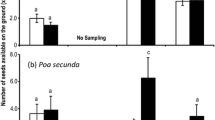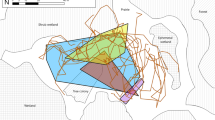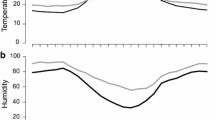Abstract
Seed-eating ants could have a significant effect on plant communities in deserts and semiarid zones. This effect is mediated through spatial and temporal foraging patterns, and seed selection within patches. Foraging patterns of harvester ants in South American deserts are almost unknown. The purpose of this work is to determine the temporal variations in the activity levels of Pogonomyrmex pronotalis and P. rastratus in the central Monte desert, and how these patterns may be related to abiotic factors, particularly to soil temperature. Activity levels and soil surface temperature were recorded at hourly intervals in five colonies for each species during the activity season (October, December, February, and April) in both 1999–2000 and 2000–2001 periods (except for October 1999). Surface ant activity starts in October, increases between December and February, and then ceases by April. Surface ant activity is diurnal throughout the season and usually has a unique peak during midday in October and April, and two peaks in the morning and the afternoon from December to February. The proportion of the activity budget devoted to nest's maintenance activity was similar for both species. Activity levels of foraging workers tended to be higher in P. pronotalis than in P. rastratus. P. pronotalis is active between 20 and 59°C, with higher levels of activity between 35 and 45°C, whereas P. rastratus shows activity between 18 and 58°C, with higher levels of activity between 30 and 40°C. Our results suggest that temporal changes in surface activity respond mainly to soil temperature fluctuations. However, at intermediate temperatures (those probably encompassing the thermal tolerance range of these ant species), temperature appears not to be a good predictor of daily and seasonal activity fluctuations.
Similar content being viewed by others
REFERENCES
Berstein, R. A. (1974). Seasonal food abundance and foraging activity in some desert ants. Am. Nat. 108: 490–498.
Brown, J. H., Reichman, O. J., and Davidson, D. W. (1979). Granivory in desert ecosystems. Annu. Rev. Ecol. Syst. 10: 201–227.
Claver, S., and Fowler, H. G. (1993). The ant fauna (Hymenoptera: Formicidae) of the Ñacuñán Biosphere Reserve. Naturalia 18: 189–193.
Crist, T. O., and MacMahon, J. A. (1991). Foraging patterns of Pogonomyrmex occidentalis (Hymenoptera: Formicidae) in a shrub-steppe ecosystem: The roles of temperature, trunk trails, and seed resources. Environ. Entomol. 20: 265–275.
Crist, T. O., and Wiens, J. A. (1996). The distribution of ant colonies in a semiarid landscape: Implications for community and ecosystem processes. Oikos 76: 301–311.
Fellers, J. H. (1989). Interference and exploitation in a guild of woodland ants. Ecology 68: 1466–1478.
Franzel, C., and Farji-Brener, A. (2000). ¿Oportunistas o selectivas? Plasticidad en la dieta de la hormiga cortadora de hojas Acromyrmex lobicornis en el noroeste de la Patagonia. Ecol. Austral. 10: 159–168.
García-Pérez, J. A., Rebeles-Manríquez, A., and Peña-Sánchez, R. (1994). Seasonal changes in trails and the influences of temperature in foraging activity in a nest of P. barbatus. Southwest. Entomol. 19: 181–187.
Gordon, D. M. (1984). Species-specific patterns in the social activities of harvester ant colonies (Pogonomyrmex). Ins. Soc. 31: 74–86.
Gordon, D. M. (1986). The dynamics of the daily round of the harvester ant colony (Pogonomyrmex barbatus). Anim. Behav. 34: 1402–1419.
Gordon, D. M. (1991). Behavioral flexibility and the foraging ecology of seed-eating ants. Am. Nat. 138: 379–411.
Guo, Q., Thompson, D. B., Valone, T. J., and Brown, J. H. (1995). The effects of vertebrates granivores and folivores on plant community structure in the Chihuahuan desert. Oikos 73: 251–259.
Higthower, L. E. (1995). Desert ants. Science 268: 1417.
Johnson, R. (2001). Habitat segregation based on soil texture and body size in seed-harvester ants Pogonomyrmex rugosus and P. barbatus. Ecol. Entomol. 25: 402–412.
Lighton, J. R. B., and Feener, D. H. J. (1989). Water-loss rate and cuticular permeability in foragers of the desert ant Pogonomyrmex rugosus. Physiol. Zool. 62: 1232–1256.
Lopez de Casenave, J., Cueto, V. R., and Marone, L. (1998). Granivory in the Monte desert: is it less intense than in other arid zones of the world? Global Ecol. Biogeogr. Lett. 7: 197–204.
MacKay, W. P., and MacKay, E. E. (1989). Diurnal foraging patterns of Pogonomyrmex harvester ants. Southwest. Nat. 34: 213–218.
MacMahon, J. A., Mull, J. F., and Crist, T. O. (2000). Harvester ants (Pogonomyrmex spp.): Their community and ecosystem influences. Annu. Rev. Ecol. Syst. 31: 265–291.
Marone, L., Lopez de Casenave, J., and Cueto, V. R. (2000). Granivory in southern South American deserts: Conceptual issues and current evidence. BioScience 50: 123–132.
Marone, L., Rossi, B. E., and Lopez de Casenave, J. (1998). Granivore impact on solid seed reserves in the Central Monte desert, Argentina. Funct. Ecol. 12: 640–645.
Marsh, A. C. (1988). Activity patterns of some Namibian desert ants. J. Arid Environ. 14: 61–73.
Medel, R. G. (1995). Convergence and historical effects in harvester ant assemblages of Australia, North America, and South America. Biol. J. Linnean Soc. 55: 29–44.
Medel, R. G., and Vásquez, R. A. (1994). Comparative analysis of harvester ant assemblages of Argentinian and Chilean arid zones. J. Arid Environ. 26: 363–371.
Melhop, P., and Scott, N. J. (1983). The temporal patterns of seed use and availability in a guild of desert ants. Ecol. Entomol 8: 69–85.
Morton, R. S. (1985). Granivory in arid regions: Comparison of Australia with North America and South America. Ecology 66: 1859–1866.
Mull, J. F., and MacMahon, J. A. (1996). Factors determining the spatial variability of seed densities in a shrub-steppe ecosystem: The role of harvester ants. J. Arid Environ. 32: 181–192.
Munger, J. C. (1984). Long-term yield form harvester ant colonies: Implication for horned lizard foraging strategy. Ecology 65: 1077–1086.
Porter, S.D., and Tschinkel, W. R. (1987). Foraging in Solenopsis invicta (Hymenopera: Formicidae): Effects of weather and season. Environ. Ecol. 16: 802–808.
Pulliam, H. R., and Brand, M. R. (1975). The production and utilization of seeds in plains grassland of southeastern Arizona. Ecology 56: 1158–1166.
Reichman, O. J. (1979). Desert granivore foraging and its impact on seed densities and distributions. Ecology 60: 1085–1092.
Retana, J., Cerdá, X., Alsina, A., and Bosch, J. (1988). Importancia ded alimento sólido y del alimento líquido en el régimen trófico de la hormiga Cataglyphis cursor (Formicidae). Acta Oecol. 9: 101–109.
Retana, J., Cerdá, X., Alsina, A., and Bosch, J. (1998). Field observations of the ant Camponotus sylvaticus (Hym: Formicidae): Diet and activity patterns. Acta Oecol./Oecol. Generalis 9: 101–109.
Rogers, L. E. (1974). Foraging activity of the western harvester ant in the shortgrass plains ecosistems. Environ. Ecol. 3: 420–424.
Steinberger, Y., Leschner, H., and Schmida, A. (1992). Activity pattern of harvester ants (Messor spp.) in the Negev desert ecosystem. J. Arid Environ. 23: 169–176.
Taber, S. W. (1998). The world of the Harvester Ant, A & M University Press, College Station, TX.
Weier, J. A., and Feener, D. H. J. (1995). Foraging in the seed-harvester ant genus Pogonomyrmex: Are energy costs important? Behav. Ecol. Sociobiol. 36: 291–300.
Whitford, W.G., and Bryant, M. (1979). Behavior of a predator and its prey: The horned lizard (Phrynosoma cornutum) and harvester ants (Pogonomyrmex spp.). Ecology 60: 686–694.
Whitford, W. G., and Ettershank, G. (1975). Factors affecting foraging activity in Chihuahuan desert harvester ants. Environ. Entomol. 4: 689–696.
Whitford, W. G., Forbes, G. S., and Kerley, G. I. (1995). Diversity, spatial variability, and functional roles of invertebrates in desert grassland ecosystems. IN McClaran, M.P. and Van Devender, T.R. (eds.), The Desert Grassland, The University of Arizona Press, Tucson, AZ, pp. 152–195.
Zar, J. H. (1996). Biostatistical Analysis, 3rd edn., Prentice-Hall, Upper Saddle River, NJ.
Author information
Authors and Affiliations
Rights and permissions
About this article
Cite this article
Pol, R., de Casenave, J.L. Activity Patterns of Harvester Ants Pogonomyrmex pronotalis and Pogonomyrmex rastratus in the Central Monte Desert, Argentina. Journal of Insect Behavior 17, 647–661 (2004). https://doi.org/10.1023/B:JOIR.0000042546.20520.c8
Issue Date:
DOI: https://doi.org/10.1023/B:JOIR.0000042546.20520.c8




